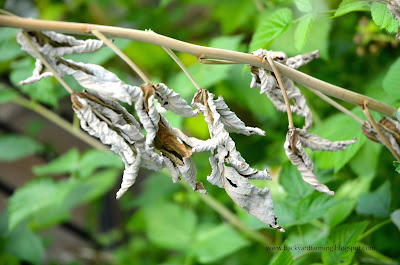Raspberries are fairly easy to grow, but they can fall prey to certain pests and conditions. Here's an incident report from recent activity in my patch.
1. The evidence: Shredded ripe berries next to next to untouched unripe berries.
Further investigation: One morning after picking a few berries I was surprised to notice little black bugs scampering inside the bowl of fruit I'd picked. I hadn't seen them on the outside the berries at all when I harvested. I looked more closely as I picked the next few, and lo and behold, it was like clowns piling out of a Volkswagen.
The culprit: Beetles that go by the name picnic or sap. These 1/4-inch long bugs are attracted to ripe, decaying fruit initially, but once drawn to the garden can also harm unripe berries. Since this beetle doesn't damage the plant, it is more a nuisance than a hard-core criminal.
Control through regular harvest and removal of decaying berries. (Source: askextension.org.)
2. The evidence: Multiple reports of dry, wilted leaves.
Further investigation. Pay attention to the scope and spread of wilted leaves to be able to pinpoint the perpetrator. For instance, the above picture shows some dried leaves in the middle of an otherwise healthy cane. It was most likely caused by water stress at the time those affected leaves unfurled. Pluck off the dried leaves and you're good to go.
In contrast, the picture below is of thoroughly dried out cane, surrounded by other healthy canes. Such isolation suggests the presence of a pest within the cane, not a widespread water or soil issue. A raspberry cane borer is the likely suspect. The adult females poke holes in the canes in spring and lay eggs. After the larvae hatch they tunnel downward toward the roots to overwinter. (Source: organicgardening.about.com).
Control by removing affected canes. Discard or burn rather than compost, to ensure any critters inside the canes don't get out on parole for a new generation of pests next season.
3. The evidence: Holes in leaves. Again, look for different calling cards. Bite marks from the exterior of leaves signal grasshoppers.
Holes in the middle of leaves, particularly those that go around the leaf's veins, come from caterpillars, such as the larvae of the raspberry sawfly or the raspberry fruitworm beetle. (Source: http://www.omafra.gov.on.)
Control all of these with hand-picking or an easy DIY bugspray, featured here.
By the way, the yellowing of these raspberry leaves is easily corrected through addition of iron to the soil.

4. Circumstantial evidence: Birds!
Control through netting or frequent visits from my favorite kind of raspberry thief:
Conclusion: Patrol your patch regularly and remove and destroy canes whose wilting leaves show signs of insect intruders. Harvest berries before they get overripe and attract picnic beetles to the decaying fruit. Sporadic leaf munchers won't affect production in an otherwise healthy patch, but you may chose to use insecticide or an organic spray.









No comments:
Post a Comment